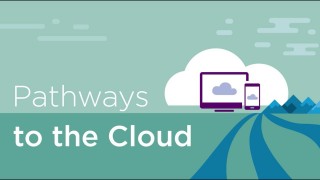3 trends driving higher education to the cloud

Key takeaways
- Adopt a mobile-first strategy and make the move to the cloud simple
- The cloud can expand or contract all the data collection and data analytics that take place
- Adding cloud services in the right way adds security for institutions
Those who are making the move to the cloud should treat the shift as a full transition from one technology stack to another, says Shelton Waggener, senior vice president of Internet2. “The difference from on-premises transitions (like mainframe to mini, client server to web server) is that the technology stack isn’t one that you build locally,” he says. “Cloud platforms simply move much faster than any previous technology transition. This migration is accelerating the pressure on chief information officers globally, across all industries, to evaluate their technical platform strategies. You simply cannot avoid being in the cloud, whether you want to or not.”
“Three dimensions, without question, drive higher education CIOs’ need for the cloud. Surprisingly, none of them has to do with cost, which is where many people start and end their thinking about the cloud. While costs are a substantial issue and certainly a consideration worth engaging in and building a strategy around, that isn’t really the most significant driver. Instead, there are three trends around cloud that are the most significant drivers: mobile-first strategy, big data, and security,” says Waggener.
“The question of moving to the cloud is driven not by the cloud itself but by its alignment with the mission of higher education as an industry, who we are culturally and practically. We must collaborate to learn, innovate and advance scholarship. We’re geographically diverse across multiple campuses—even within single universities—and across institutions, so the collaboration with each other is critical. Social media and social networking have provided the means for people to stay online and be connected at all times. Everyone is using the cloud daily, removing the question whether you should adopt the cloud or not. In fact, your institution is already adopting the cloud as a primary computing platform. The CIO’s job is to find ways to make your institution’s move to the cloud as simple as it is for people to adopt applications on a smartphone.”
As an example, Waggener points to changes in the way students currently interact with institutions. In the past, colleges designed courses with physical time and space constraints in mind. Today, however, those barriers no longer exist. “Students don’t think in terms of constrained environments. Just like they do in the real world, they need to be able to make decisions in real time, all the time,” he says.
Another essential part of the technology shift, according to Waggener, is big data. “The big data dimension of cloud computing is more than the shift from owning infrastructure: It is now allowing for the ability to handle all the capacities, indexing, and management of the data or the applications environment that optimise your administration.”
“Most savvy CIOs have recognised that what matters isn’t the computing power, storage, or even the application but the data itself. And not just the data but the metadata—the data about the data. If you think in terms of all the technology activities we do every day, every click on a device, every page view, every consideration of a student or a faculty member is actually a data point to be managed, secured, and privacy protected. That’s the responsibility of the CIO.”
“You need a technology environment that can expand or contract all the data collection and data analytics that take place,” he adds. “If you’re going to build your own data center to accommodate all the possible use cases (particularly for supporting research use cases), you need a lot of land and a lot of electricity. That’s just not a viable path for our resource-constrained universities.”
Finally, security presents a special challenge for institutions not only because of their collaborative nature but also because of the thousands of individuals who come to higher education fully connected through many of their own devices. How do you secure such a wide array of environments? The old days of building central environments and trying to secure them is no longer effective (nor possible given budget constraints).
Waggener says that institutions that are avoiding moving anything to the cloud shouldn’t fear security, however. “What we’re seeing is cloud companies whose very survival is based on the security of their customers’ data. They invest a much greater percentage of their resources in security than higher education is able to allocate. By carefully considering options and adding cloud services in the right way, universities are actually adding security. I really believe that being in the cloud gives our higher education institutions the opportunity to be more secure than they would be by themselves.”
SHELTON WAGGENER, Senior Vice President, Internet2
Shelton Waggener is the senior vice president of Internet2, a U.S. national research and education network. A recognised leader in cloud technology, Shelton oversees the Internet2 NET+ cloud services programme, which provides community and customised commercial cloud services such as security, infrastructure, platform, software, and research environments to more than 300 U.S. universities. Prior to joining Internet2, Shelton served as associate vice chancellor and CIO of the University of California, Berkeley.
To help you plan your journey to the cloud, please visit our Pathways to the Cloud page.




